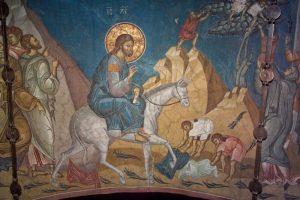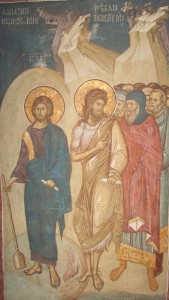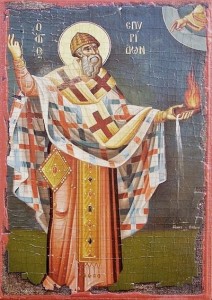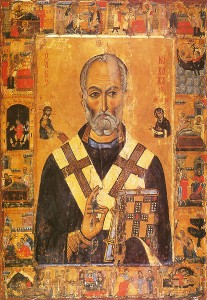Equal to the apostles and teachers of the Slavs, divinely-wise Cyril and Methodius, pray to the Vladika of all to strengthen all Slavonic nations in Orthodoxy and unity of mind, to convert and reconcile the world to God and to save our souls.
Troparion (Tone 4) Continue reading
Category Archives: Church Holiday
The Entrance of the Lord into Jerusalem
 May the great day of the Entrance of the Lord into Jerusalem remind us of His tears and sacred wrath, that we might never forget His bitter tears and words, directed not only to Jerusalem, but also to each one of us! Let us place it as a goal of our life to follow Christ, for He Himself said, If any man serve me, let him follow me; and where I am, there shall also my servant be (Jn. 12:26). Let us follow Christ, through the straight gate and narrow way—and we shall find rest in the place where shines the eternal glory of the Holy Trinity.
May the great day of the Entrance of the Lord into Jerusalem remind us of His tears and sacred wrath, that we might never forget His bitter tears and words, directed not only to Jerusalem, but also to each one of us! Let us place it as a goal of our life to follow Christ, for He Himself said, If any man serve me, let him follow me; and where I am, there shall also my servant be (Jn. 12:26). Let us follow Christ, through the straight gate and narrow way—and we shall find rest in the place where shines the eternal glory of the Holy Trinity.
St. Luke, Archibishop of Crimea
Presentation of our Lord in the Temple
Speaking about the spread and celebration of Christmas, St. John Chrysostom says: ” Magnificent and noble trees when planted in the ground shortly attain great heights and become heavily laden with fruit; so it is with this day.” So it is with the day of the Meeting of our Lord in the Temple. Continue reading
Homily about Submission to the Will of God
 “Your will be done, on earth as in heaven” (Mat. 6:10)
“Your will be done, on earth as in heaven” (Mat. 6:10)
Blessed be John the Baptist, for he fulfilled the Gospel before the arrival of the Gospel! Going into the wilderness, he gave himself up completely to the will of God, both body and soul. The will of God was carried out in his body on earth as well as in the heaven of his soul. Neither hunger nor wild beasts did harm his body throughout the many years that he spent in the wilderness. Neither was his soul harmed by despair because of loneliness, nor pride because of heavenly visions. He did not seek from man either bread or knowledge. God granted him everything that was necessary for him because he gave himself up completely to the will of God.
So it is with the Most Holy Trinity

At the First Council in Nicaea, Holy Hierarch Saint Spyridon gave the Arians a graphic proof of the Unity within the Holy Trinity.
He took a brick into his hands, and squeezed it. Immediately, flame shot up from it, water poured down from it, and clay remained in the hands of the miracle worker. Then Saint Spyridon said, “Here are three elements, but one brick. So it is with the Most Holy Trinity: Three Faces, but One Divinity.”
Saint Nicholas the Wonderworker
 In icons of Saint Nicholas, the Lord Savior is usually depicted on one side with a Gospel in His hands, and the Most-Holy Theotokos – on the other side with an episcopal omophorion in her hands. This has a twofold historical significance: first, it signifies the calling of Nicholas to the hierarchical office, and second, it signifies his release from the condemnation that followed his confrontation with Arius.
In icons of Saint Nicholas, the Lord Savior is usually depicted on one side with a Gospel in His hands, and the Most-Holy Theotokos – on the other side with an episcopal omophorion in her hands. This has a twofold historical significance: first, it signifies the calling of Nicholas to the hierarchical office, and second, it signifies his release from the condemnation that followed his confrontation with Arius.
St. Methodius, Patriarch of Constantinople, writes: “One night St. Nicholas saw our Savior in glory, standing by him and extending to him the Gospel, adorned with gold and pearls. On his other side, he saw the Most-Holy Theotokos placing the episcopal omophorion on his shoulders”. Shortly after this vision, John the Archbishop of Myra died and Saint Nicholas was appointed archbishop of that city. That was the first event. Continue reading
The Protection of the Most-Holy Theotokos
From time immemorial, the Church has celebrated the Most-Holy Theotokos as the patroness and protectress of the Christian people, Who, by Her intercessory prayers, implores God’s mercy for us sinners. Continue reading
The Beheading of Saint John the Baptist
Herod Antipas, son of the elder Herod, who was the slayer of the children of Bethlehem at the time of the birth of the Lord Jesus, was ruler of Galilee at the time when John the Baptist was preaching. This Herod was married to the daughter of Aretas, an Arabian prince. But Herod, an evil sprout of an evil root, put away his lawful wife and unlawfully took unto himself Herodias as his concubine, the wife of his brother Philip, who was still living. John the Baptist stood up against this lawlessness and strongly denounced Herod who then cast John into prison. Continue reading
The Transfiguration of the Lord
Forty days before He was delivered to an ignominious death for our sins, our Lord revealed to three of His disciples the glory of His Divinity. Continue reading
Sunday of All Saints
The Holy Church commemorates Saints every day. But because there have been God-pleasers who struggled in obscurity and were not revealed to the Holy Church, the Church has set a day on which we praise all those who have pleased God throughout the ages, that they all might be glorified by the Church. Continue reading
